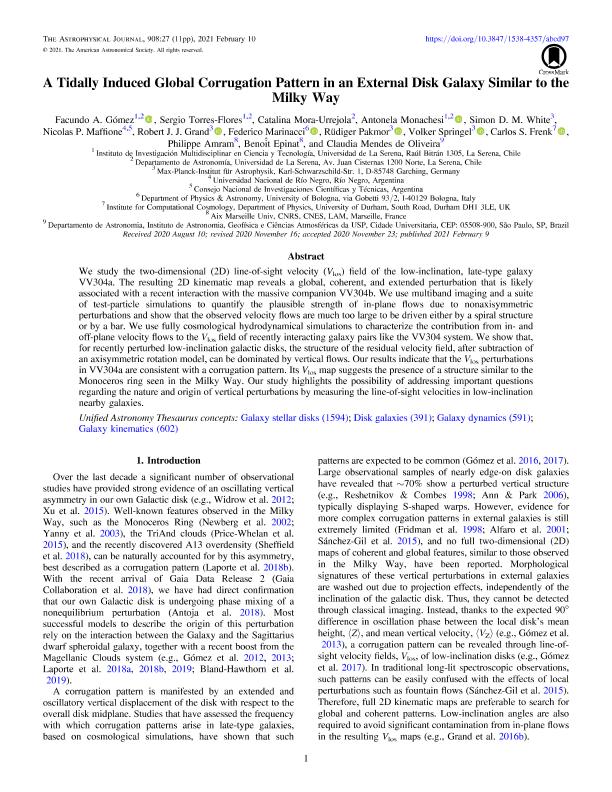Mostrar el registro sencillo del ítem
dc.contributor.author
Gómez, Facundo A.
dc.contributor.author
Torres-Flores, Sergio
dc.contributor.author
Mora Urrejola, Catalina
dc.contributor.author
Monachesi, Antonela

dc.contributor.author
White, Simon D. M.
dc.contributor.author
Maffione, Nicolas Pablo

dc.contributor.author
Grand, Robert J. J.

dc.contributor.author
Marinacci, Federico

dc.contributor.author
Pakmor, Radiger

dc.contributor.author
Springel, Volker
dc.contributor.author
Frenk, Carlos S.
dc.contributor.author
Amram, Philippe
dc.contributor.author
Epinat, Benoit
dc.contributor.author
De Oliveira, Claudia Mendes
dc.date.available
2022-02-09T16:37:28Z
dc.date.issued
2021-02
dc.identifier.citation
Gómez, Facundo A.; Torres-Flores, Sergio; Mora Urrejola, Catalina; Monachesi, Antonela; White, Simon D. M.; et al.; A tidally induced global corrugation pattern in an external disc galaxy similar to the Milky Way; IOP Publishing; Astrophysical Journal; 908; 1; 2-2021; 1-11
dc.identifier.issn
0004-637X
dc.identifier.uri
http://hdl.handle.net/11336/151681
dc.description.abstract
We study the two-dimensional (2D) line-of-sight velocity (Vlos) field of the low-inclination, late-type galaxy VV304a. The resulting 2D kinematic map reveals a global, coherent, and extended perturbation that is likely associated with a recent interaction with the massive companion VV304b. We use multiband imaging and a suite of test-particle simulations to quantify the plausible strength of in-plane flows due to nonaxisymmetric perturbations and show that the observed velocity flows are much too large to be driven either by a spiral structure or by a bar. We use fully cosmological hydrodynamical simulations to characterize the contribution from in- and off-plane velocity flows to the Vlos field of recently interacting galaxy pairs like the VV304 system. We show that, for recently perturbed low-inclination galactic disks, the structure of the residual velocity field, after subtraction of an axisymmetric rotation model, can be dominated by vertical flows. Our results indicate that the Vlos perturbations in VV304a are consistent with a corrugation pattern. Its Vlos map suggests the presence of a structure similar to the Monoceros ring seen in the Milky Way. Our study highlights the possibility of addressing important questions regarding the nature and origin of vertical perturbations by measuring the line-of-sight velocities in low-inclination nearby galaxies.
dc.format
application/pdf
dc.language.iso
eng
dc.publisher
IOP Publishing

dc.rights
info:eu-repo/semantics/openAccess
dc.rights.uri
https://creativecommons.org/licenses/by/2.5/ar/
dc.subject
GALAXIES: STELLAR DISCS
dc.subject
METHODS: NUMERICAL
dc.subject
GALAXIES: STELLAR CONTENT
dc.subject.classification
Astronomía

dc.subject.classification
Ciencias Físicas

dc.subject.classification
CIENCIAS NATURALES Y EXACTAS

dc.title
A tidally induced global corrugation pattern in an external disc galaxy similar to the Milky Way
dc.type
info:eu-repo/semantics/article
dc.type
info:ar-repo/semantics/artículo
dc.type
info:eu-repo/semantics/publishedVersion
dc.date.updated
2022-01-25T14:41:03Z
dc.journal.volume
908
dc.journal.number
1
dc.journal.pagination
1-11
dc.journal.pais
Reino Unido

dc.journal.ciudad
Londres
dc.description.fil
Fil: Gómez, Facundo A.. Universidad de La Serena; Chile
dc.description.fil
Fil: Torres-Flores, Sergio. Universidad de La Serena; Chile
dc.description.fil
Fil: Mora Urrejola, Catalina. Universidad de La Serena; Chile
dc.description.fil
Fil: Monachesi, Antonela. Universidad de La Serena; Chile. Consejo Nacional de Investigaciones Científicas y Técnicas; Argentina
dc.description.fil
Fil: White, Simon D. M.. Gobierno de la República Federal de Alemania. Max Planck Institut für Astrophysik; Alemania
dc.description.fil
Fil: Maffione, Nicolas Pablo. Universidad Nacional de Rio Negro. Sede Andina. Escuela de Producción, Tecnología y Medio Ambiente; Argentina. Consejo Nacional de Investigaciones Científicas y Técnicas. Centro Científico Tecnológico Conicet - Patagonia Norte; Argentina
dc.description.fil
Fil: Grand, Robert J. J.. Gobierno de la República Federal de Alemania. Max Planck Institut für Astrophysik; Alemania
dc.description.fil
Fil: Marinacci, Federico. Università di Bologna; Italia
dc.description.fil
Fil: Pakmor, Radiger. Gobierno de la República Federal de Alemania. Max Planck Institut für Astrophysik; Alemania
dc.description.fil
Fil: Springel, Volker. Gobierno de la República Federal de Alemania. Max Planck Institut für Astrophysik; Alemania
dc.description.fil
Fil: Frenk, Carlos S.. University of Durham. Department of Physics; Reino Unido
dc.description.fil
Fil: Amram, Philippe. Centre National de la Recherche Scientifique; Francia
dc.description.fil
Fil: Epinat, Benoit. Centre National de la Recherche Scientifique; Francia
dc.description.fil
Fil: De Oliveira, Claudia Mendes. Universidade do Sao Paulo. Instituto de Astronomia, Geofísica e Ciências Atmosféricas; Brasil
dc.journal.title
Astrophysical Journal

dc.relation.alternativeid
info:eu-repo/semantics/altIdentifier/doi/http://dx.doi.org/10.3847/1538-4357/abcd97
dc.relation.alternativeid
info:eu-repo/semantics/altIdentifier/url/https://iopscience.iop.org/article/10.3847/1538-4357/abcd97
Archivos asociados
